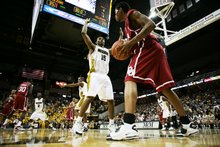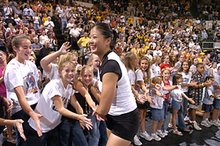I’ve fallen off the wagon in terms of the 2006 stat analysis, but here’s your next installment. So far I’ve looked at success rates for QB’s, RB’s, and WR/TE’s...now it’s time to look at line play.
There is no perfect tool for evaluating an O-line without watching every play of every game and grading each player out like coaches do. I wouldn’t have the time for that even if I had access to tapes of all the games. Just ain’t gonna happen. That said, Football Outsiders use a tool called Line Yards. I’ve used it for my ‘Beyond the Box Score’ bits, and I’m going to dig it back out now to measure run-blocking effectiveness.
Line Yards is once again defined by Football Outsiders as follows:• For a play that resulted in negative yards, the O-line is granted 120% of the effort (i.e. a 3-yard loss would be a 3.6-yard loss for the O-line).
Obviously this tool is far from perfect, as it doesn’t pay heed to the abilities of the people running or throwing the ball. You open up the same-sized hole for Adrian Peterson or Jon Cornish as you do for Paul Mosley or Stevie Hicks, and you’re not going to get the same yards every time. The RB still has to hit the holes and maybe break some tackles. That said, capping the possible gain at least takes an RB’s explosiveness (and the occasional big-play outlier) out of the equation. Whether an RB gains 10 yards or 20 or 80, the O-line did its job, and it gets max credit for it.
• For a play that resulted in a 0-4 yard gain, the O-line is granted 100%.
• For a play that resulted in a 5-10 yard gain, the O-line is granted 50% of the yards over 4 (i.e. an 8-yard gain would be a 6-yard gain for the O-line).
• For a play that resulted in a 10+ yard gain, the O-line get no extra credit—by that point, the runner is into the secondary, and the line won’t get much chance to block. Therefore (if the math in my head is correct), the most credit an O-line can get is 7.5 yards.
So here are the 2006 line yards. Two qualifiers: these are only conference games, and these stats—like most others I use—are only for when the game is within two possessions. If you’re down 30 and the other team brings in its second-string nickel package, you can probably run for 8 yards a pop no matter who you are...and it would prove nothing.
2006 Line Yards (Conference Average: 2.86)
1. Kansas – 222 attempts, 763.5 yards, 3.44 average (Value Over Average* : 1.20)
2. Oklahoma State – 260 attempts, 851.8 yards, 3.28 average (VOA: 1.15)
3. Nebraska – 279 attempts, 877.8 yards, 3.15 average (VOA: 1.10)
4. Texas – 214 attempts, 673.1 yards, 3.15 average (VOA: 1.10)
5. Colorado – 220 attempts, 685.9 yards, 3.12 average (VOA: 1.09)
6. Texas A&M – 330 attempts, 993.8 yards, 3.01 average (VOA: 1.05)
7. Oklahoma – 314 attempts, 878.9 yards, 2.80 average (VOA: 0.98)
8. Missouri – 192 attempts, 532.4 yards, 2.77 average (VOA: 0.97)
9. Kansas State – 188 attempts, 511.4 yards, 2.72 average (VOA: 0.95)
10. Texas Tech – 84 attempts (!!), 217.3 yards, 2.59 average (VOA: 0.91)
11. Iowa State – 174 attempts, 438.5 yards, 2.52 average (VOA: 0.88)
12. Baylor – 104 attempts, 188.0 yards, 1.81 average (VOA: 0.63)
* Value Over Average just signifies a team’s performance/value compared to the conference average. 1.00 = conference average. 1.20 = 20% over the conference average. 0.80 = 20% below the conference average. Et cetera.
Thoughts:• Jon Cornish led the league in rushing, so it would make sense that Kansas would be #1.
Okay, so that works pretty decently for a line’s performance in the rushing category. What about passing? What’s an O-line’s main job in pass blocking? Not getting the QB sacked, of course. It would make sense, then, that a statistic like Sack Rate (sacks divided by passing attempts) could be used. Now, this comes with the same “everybody’s different” issues as Line Yards. A sack rate could depend just as much on a QB’s ability to avoid oncoming rushers and make a quick decision or the overall ability of the WR’s and TE’s to actually get open. But as with Line Yards, the Sack Rate will tell something, right?
• Oklahoma State at #2 surprised me simply because I figured a lot of their yards came off of big runs (I suspected the same out of K-State and was correct on that one). Instead this shows a pretty decent consistency.
• Texas A&M and OU were rated #1 and #2 in most unit rankings coming into this season, but their totals weren’t nearly as high as I would have thought.
• I’m thinking Colorado didn’t run the ball enough, eh? With Bernard Jackson’s arm and the Buffs’ cruddy receivers, Coach Nick Nolte’s offensive schemes didn’t really match the talent. And by “didn’t really match” I mean “was terribly, disastrously at odds with.”
• When games were within two possessions, Texas Tech averaged about 10.5 rushes per game. That’s insane. I mean, I knew it would be a small number—duh, they’re Texas Tech—but that’s...well, insane.
As we delve into Sack Rate, we should take into account the fact that there’s a higher rate of sacks on third (and fourth) downs than on first and second. Makes sense. Third downs see more pass situations and therefore see more blitzes. So since preventing sacks on first/second downs and third/fourth downs are really sort of two different skills, what we’re going to do here is look at both the sack rates for both and hold them as separate entities, comparing them both to the overall conference averages, and figuring out a way to make some judgements based off of that.
First/Second Down Sack Rate (Conference Average: 5.46%)
1. Texas Tech – 1.94%
2. Oklahoma State – 3.94%
3. Oklahoma – 4.13%
4. Missouri – 4.55%
5. Kansas – 4.88%
6. Texas A&M – 4.90%
7. Texas – 5.77%
8. Baylor – 6.15%
9. Kansas State – 6.75%
10. Iowa State – 7.94%
11. Nebraska – 8.24%
12. Colorado – 9.47%
Third/Fourth Down Sack Rate (Conference Average: 8.10%)
1. Oklahoma – 5.00%
2. Missouri – 5.19%
3. Texas Tech – 5.56%
4. Oklahoma State – 6.45%
5. Colorado – 7.55%
6. Texas A&M – 8.57%
7. Baylor – 8.82%
8. Nebraska – 8.89%
9. Texas – 9.23%
10. Kansas State – 10.45%
11. Iowa State – 10.71%
12. Kansas – 11.25%
So if we combine those two figures two the conference average, we can come up with some sort of rough “Value Over Average” (VOA) number. If you really want to know the formula I used for this, let me know...otherwise I’m thinking that a boring explanation of it would just distract from the numbers themselves.
Sack Rate VOA – O-Line
1. Texas Tech – 1.41
2. Oklahoma – 1.17
3. Missouri – 1.14
4. Oklahoma State – 1.11
5. Texas A&M – 0.98
6. Kansas – 0.93
7. Texas – 0.92
8. Baylor – 0.92
9. Colorado – 0.88
10. Kansas State – 0.86
11. Nebraska – 0.86
12. Iowa State – 0.82
Thoughts:• This really might be a pretty decent measure, as it doesn’t seem to give any benefit to the more elusive QB’s in the conference, like Bernard Jackson. Graham Harrell’s as stationary as they come—though he also gets rid of the ball quicker than anybody in the world—and Tech was far and away #1.
Okay, so now what happens if we combine the two “VOA” figures? Despite all of the limitations I mentioned above, this would still give us a decent read of who did the best job in combination run/pass blocking, right?
• I think it’s safe to say that Kansas was horrid at protecting from blitzes. On first and second downs, they were as good at avoiding the sack as anybody (outside Lubbock, anyway). On third and fourth downs, they were worse than Iowa State. Guess that might say something about the abilities of Kerry Meier, Adam Barmann, and Todd Reesing to make quick decisions, but it also says something about the O-line.
In this case, I guess you could say 2.00 = conference average, since it’s combining two averages.
Combined VOA – Offensive Line
1. Texas Tech – 2.32
2. Oklahoma State – 2.26
3. Oklahoma – 2.15
4. Kansas – 2.13
5. Missouri – 2.10
6. Texas A&M – 2.03
7. Texas – 2.02
8. Colorado – 1.97
9. Nebraska – 1.96
10. Kansas State – 1.81
11. Iowa State – 1.70
12. Baylor – 1.55
I think this does a pretty good job of comparing a team’s O-line talent to how it matches up with the offensive system. I’m sure Oklahoma (#3) and Texas (#7) had more NFL talent than Tech (#1) and OSU (#2) last year, but that didn’t allow them to do a better job. I do find ATM’s standing (#6) interesting considering how good people seemed to think they were this offseason. These numbers suggest that ATM’s rushing performance last year was due much more to the McGee-Goodson-Lane attack than the performance of the O-line...which makes sense to me. Mizzou didn’t have a problem with ATM’s running game last year until having to tackle Lane and chase Goodson 90 times (it felt like 90, anyway) caught up with them.
Next time, I’ll look at D-line performance using the same approach.
Friday, September 21, 2007
Stats Stats Stats: 2006 (O-Line)
Posted by
The Boy
at
10:11 AM
![]()
Labels: Stats Stats Stats
Subscribe to:
Comment Feed (RSS)






|